Contents
Hydrangea macrophylla
Hydrangea macrophylla, commonly known as bigleaf hydrangea or French hydrangea, is a deciduous flowering shrub prized for its large, showy blossom clusters. It is a staple of summer gardens, producing vibrant pom-pom or lacecap blooms that can range from deep blue to pink, purple, or white depending on the variety and soil conditions. This species features broad, glossy green leaves and a naturally mounding, rounded form. Gardeners cherish H. macrophylla for its long blooming season and striking presence as one of the classic blue flowers in temperate landscapes. With proper care, these hydrangeas become eye-catching focal points in mixed borders, foundation plantings, or container gardens. The plant’s combination of lush foliage and dramatic blossoms adds a timeless charm to cottage gardens and shaded patios alike. In this profile, we cover the key aspects of Hydrangea macrophylla care, from its origins and taxonomy to practical tips on cultivation, ensuring a comprehensive guide for both novice and experienced gardeners.
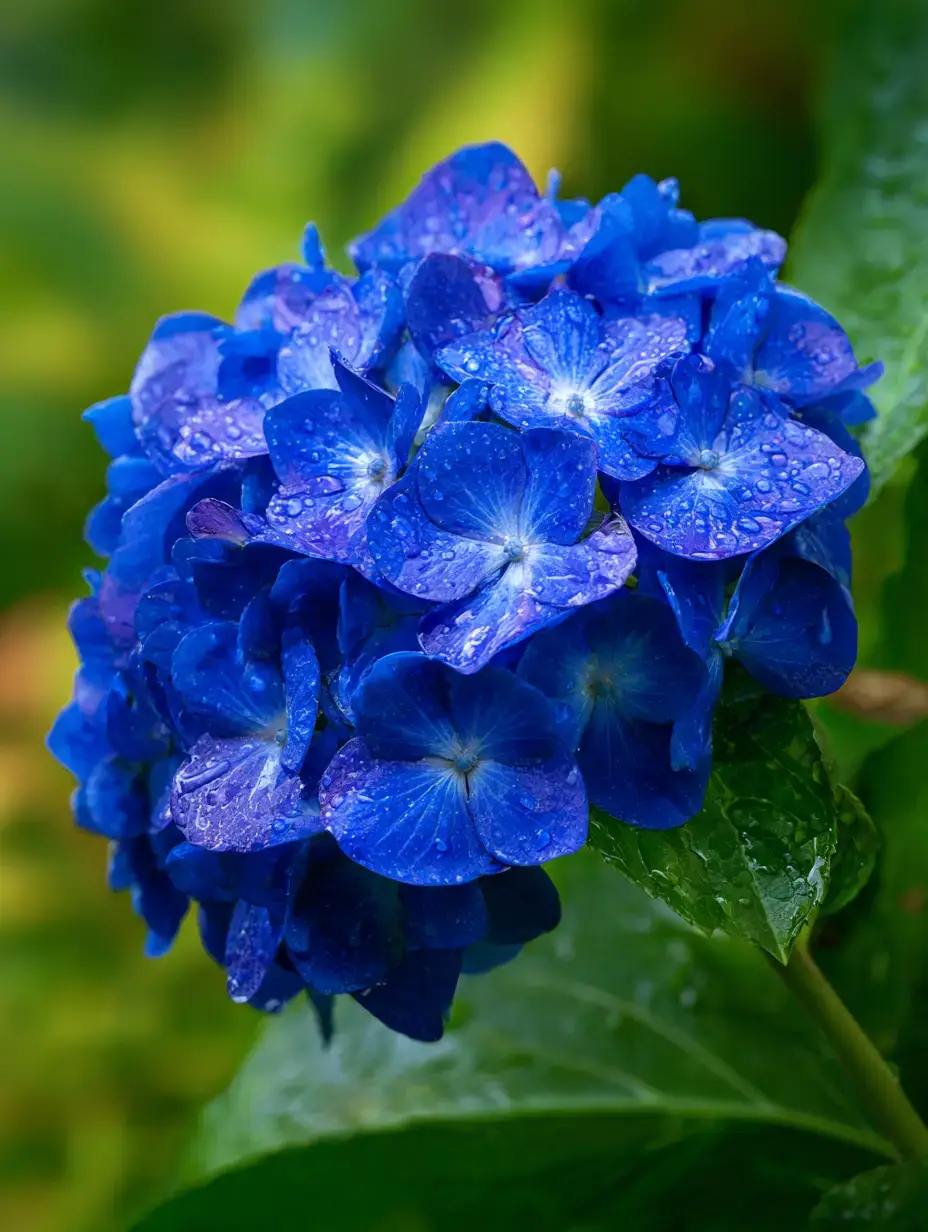
🌱 Taxonomy and origin
Hydrangea macrophylla belongs to the hydrangea family (Hydrangeaceae) and is one of the most well-known species in the types of flowers category for ornamental gardening. The genus name “Hydrangea” comes from Greek words meaning “water vessel,” referring to the cup-like shape of its seed capsules. The species name “macrophylla” means “large leaf,” alluding to this plant’s big, fleshy leaves. Hydrangea macrophylla is native to parts of Japan, Korea, and coastal China, where it grows in wooded valleys and moist, shaded mountain slopes. It was introduced to European horticulture in the 18th century, famously gaining the name “hortensia” after a French astronomer’s muse named Hortense. Over time, breeding programs expanded its popularity worldwide. Today, countless cultivars and hybrids exist, showcasing various bloom forms and colors. Despite often being nicknamed French hydrangea, it did not originate in France – instead, that moniker reflects the plant’s early popularity in European gardens. Understanding its Asian origin helps explain its preference for temperate climates and monsoon-like moisture patterns. In the wild, it thrives under tree canopies with rich soil and ample rainfall, conditions gardeners aim to replicate when cultivating this beloved shrub.
🌸 Bloom time
Hydrangea macrophylla typically blooms from late spring through summer. In many regions the main flush of flowers appears in mid-summer (often June through July), when large mophead or delicate lacecap blossoms open on the prior year’s growth. The bloom time can extend into August and even early fall for reblooming varieties or in cooler climates, giving several weeks of garden color. Each flower cluster can remain attractive for an extended period – initial blooms are often brightly colored and then age to softer shades of green, pink, or parchment into late season. Gardeners appreciate that the spent blooms often linger in a dried form on the plant, providing ornamental interest well into autumn. Bigleaf hydrangeas generally form their flower buds on “old wood” (stems from the previous year). This means that the timing of blooms depends on buds surviving the winter. Modern reblooming cultivars (such as the Endless Summer series) have been developed to also flower on new wood, allowing a second wave of blossoms later in the season. These rebloomers can prolong the flowering period or ensure some bloom even after harsh winters. Overall, when sited and cared for properly, H. macrophylla offers a long bloom season with dramatic color, making it a highlight of summer gardens year after year.
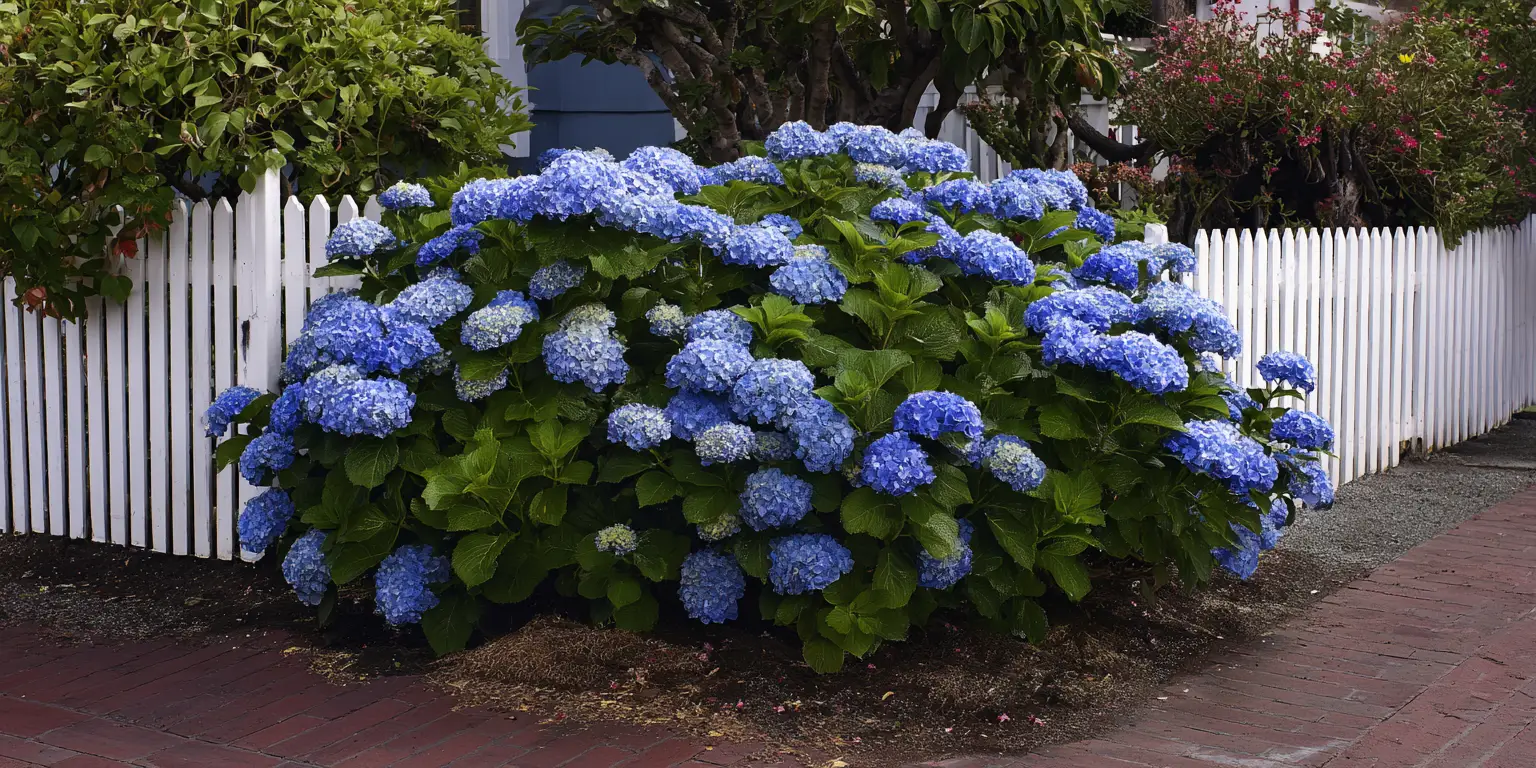
📏 Height and spread
Bigleaf hydrangea is a medium-sized deciduous shrub with a rounded growth habit. At maturity, a typical Hydrangea macrophylla reaches about 3 to 6 feet in height, with a similar spread of 3 to 6 feet across. The plant tends to branch low and form a full, mounded shape composed of multiple stems arising from the base. In ideal conditions, especially rich soil and partial shade, some cultivars may grow slightly larger – occasionally up to 7 or 8 feet tall – but most stay within the 3-6-foot range which makes them well-suited to foundation plantings and borders. Dwarf or compact varieties also exist, bred to remain around 2 to 3 feet tall and wide, which are perfect for small gardens or container growth. Hydrangea macrophylla’s size can be managed with pruning if necessary (though heavy pruning may reduce flowering, as it blooms on old wood). When planting, allow sufficient space for its eventual spread, good airflow around the plant helps reduce disease incidence. Its moderate stature means it pairs well with both smaller perennials at its feet and taller shrubs or trees behind it. Whether used as a single specimen or grouped in a mass, the height and spread of bigleaf hydrangea contribute a lush, bushy presence that fills garden spaces with foliage and blooms without overwhelming neighboring plants.
☀️ Light
Hydrangea macrophylla grows best in partial shade conditions, thriving with a mix of sun and shade rather than full, intense sunlight all day. Ideally, these hydrangeas should receive gentle morning sun or filtered light, with protection from harsh afternoon sun. In climates with hot summers, too much direct sun can lead to leaf scorch (browned edges) and cause the plant to wilt excessively by midday. Conversely, in cooler or more northern regions, bigleaf hydrangeas can tolerate more sun, even a full sun location, provided they have ample moisture at the roots. The key is to avoid extreme exposures: an east-facing site or a spot with high dappled shade (such as under tall trees) is often ideal. In deep shade (for example, under dense evergreens or on the north side of structures), Hydrangea macrophylla may survive but likely will produce fewer blooms and become leggy as it stretches for light. Monitor your plant’s response through the seasons – if you notice pale leaves or a lack of flowers, it might be too shaded, whereas drooping, burned leaves indicate too much sun. Adjusting its site or providing midday shade with other plants can help. By giving your hydrangea the bright shade conditions it prefers, you’ll encourage healthy growth and prolific flowering while preventing stress. This balance mimics the shrub’s native woodland-edge habitat, where it receives bright but indirect light.
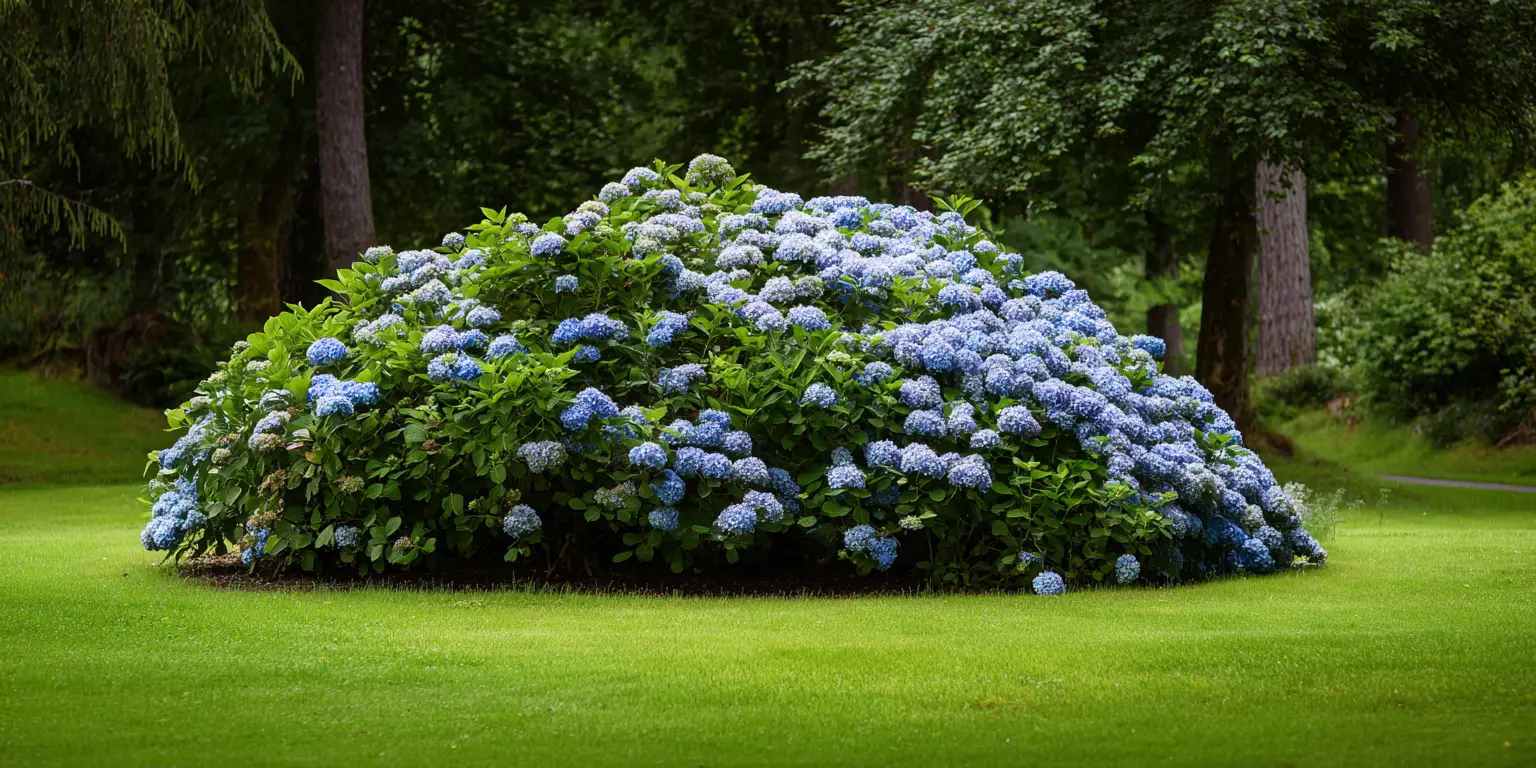
💧 Water
True to the implications of its name “Hydrangea” (hydro = water), this plant has a fairly high-water requirement. Hydrangea macrophylla performs best in evenly moist soil and should be watered regularly, especially during hot or dry weather. Consistent soil moisture is important – avoid letting the soil completely dry out, as the large leaves will quickly wilt when the plant is thirsty. Deep watering about once or twice a week (depending on rain) is recommended, it is better to soak the root zone thoroughly rather than giving light, frequent splashes. Using mulch around the base of the shrub is a helpful practice to retain soil moisture and moderate soil temperature. A 2-3-inch layer of organic mulch (like bark chips or compost) will reduce evaporation and keep roots cooler during summer heat. Hydrangea macrophylla will often signal water stress by drooping leaves in the afternoon sun. If you see wilting on a hot day, check the soil – if it’s dry, water deeply. If the soil is still moist, the wilt may simply be due to heat, and the plant should perk up by evening as temperatures drop. Avoid waterlogging the soil, while these shrubs enjoy moisture, they do not tolerate standing water or boggy conditions around their roots. Good drainage combined with regular watering is key. With adequate hydration, your hydrangea will reward you with lush foliage and full, hydrated blooms.
🌍 Soil and pH
Bigleaf hydrangeas prefer rich, well-drained soil with plenty of organic matter. A loamy soil that retains moisture but drains excess water is ideal. Working compost into the planting area can improve soil structure and fertility, which helps hydrangeas develop robust root systems. One of the most fascinating aspects of Hydrangea macrophylla is the relationship between soil pH and flower color. For many cultivars, acidic soils (approximately pH 5.0 to 5.5) produce blue or purple-blue flowers, because the plant can uptake aluminum more readily in low pH conditions, leading to blue pigmentation. In neutral to slightly alkaline soils (pH 6.0 to 7.0), those same cultivars may bloom pink or even reddish, as aluminum becomes less available to the plant. White-flowering varieties generally remain white regardless of soil pH. Gardeners can influence bloom color by adjusting soil chemistry: for example, adding garden sulfur or aluminum sulfate can gradually acidify the soil to encourage blue blooms, while adding lime can raise pH to coax pink tones. It’s important to change pH slowly and moderately – drastic additions of aluminum sulfate can damage roots. Always follow recommendations and test your soil pH first. Hydrangeas benefit from soil that is similarly suited to other acid-loving plants like azaleas, meaning a slightly acidic environment with good organic content. Ensure the soil is not extremely alkaline (above pH 7.5), as hydrangeas may develop nutrient deficiencies (like iron chlorosis) in highly alkaline ground. Regularly top-dressing with compost or a balanced, slow-release fertilizer can also keep the soil fertile and supportive of healthy growth. By providing the right soil conditions and monitoring pH, you’ll not only keep your Hydrangea macrophylla healthy but can also enjoy some control over its bloom palette.
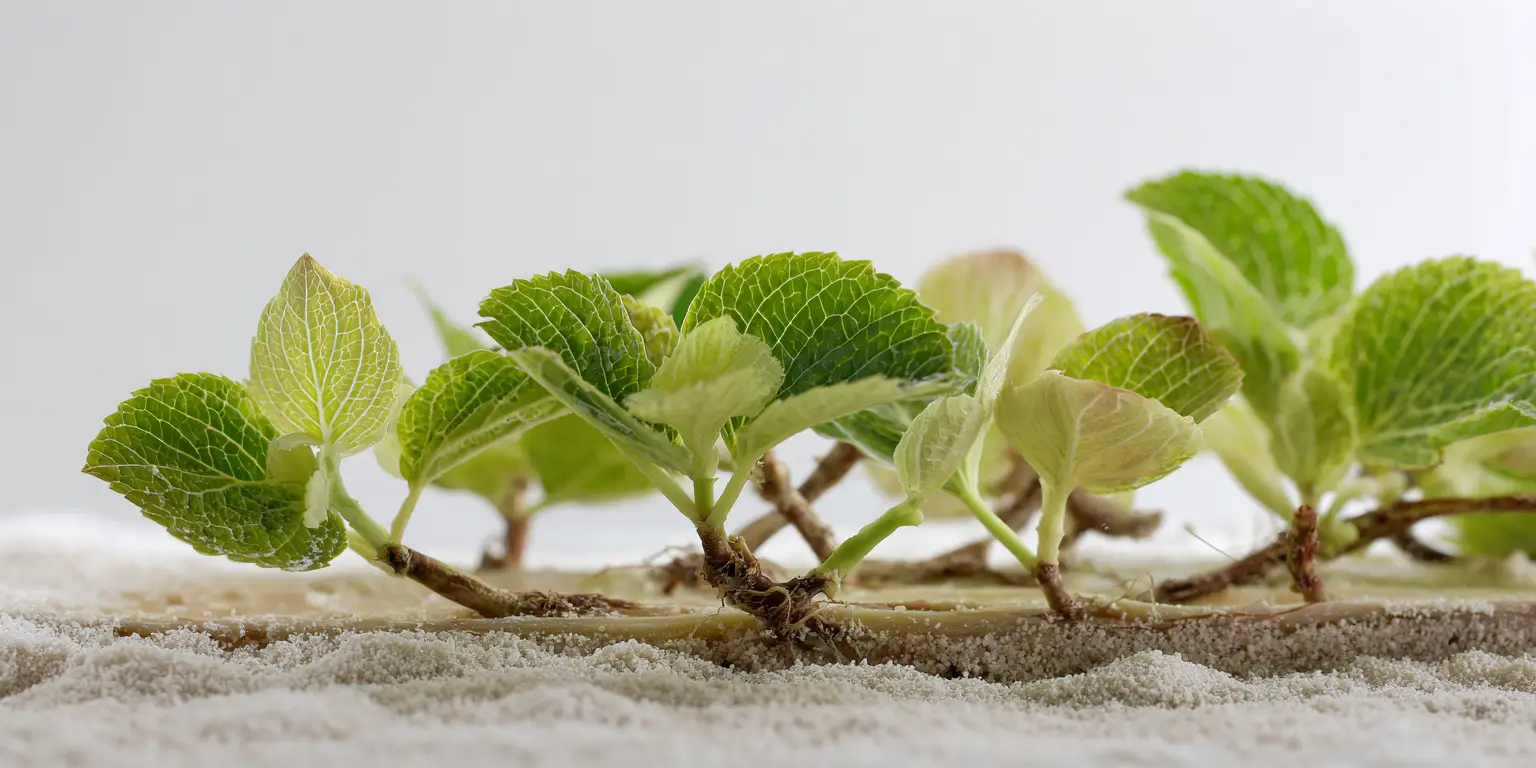
❄️ USDA hardiness
Hydrangea macrophylla is hardy in USDA Zones 6 through 9 in general, with some variation depending on the cultivar and local microclimates. In zone 6 and milder areas, bigleaf hydrangeas typically survive winter cold with only minor die-back, reliably leafing out and blooming each year. In zone 5, this species can often survive (the root and woody base are hardy to around -20°F / -29°C), but flower buds are more vulnerable to winter damage. Gardeners in zone 5 frequently find that without extra protection, their hydrangea’s old-wood buds may be killed by subzero temperatures or late spring frosts, resulting in few or no blooms the following summer. Some newer reblooming cultivars (like the popular “Endless Summer” series) have improved cold tolerance and the ability to bloom on new wood, making them better choices for zone 4 or 5 gardens. In the coldest regions where Hydrangea macrophylla is marginal, gardeners often protect their shrubs over winter by mulching heavily over the root area and covering the plant with burlap or straw insulation to shield the dormant buds from extreme cold. This can make the difference in getting blossoms in the next season. On the warmer end, up to zone 9, hydrangeas can struggle with intense heat and sun, they will need partial shade and sufficient water in hot climates to prevent stress. They generally do not thrive in tropical climates beyond zone 9 since they require a cool dormant period. When selecting a hydrangea for very cold or warm zones, check the specific hardiness rating, as some varieties are bred for extra cold hardiness or heat tolerance. Overall, with the right cultivar and a little winter care in borderline areas, gardeners across a wide range of zones can enjoy the beauty of bigleaf hydrangeas.
🌼 Propagation and longevity
Propagation of Hydrangea macrophylla is commonly done via vegetative methods to ensure new plants retain the same characteristics as the parent (since most garden plants are cultivars). The two most gardener-friendly methods are stem cuttings and layering. Softwood stem cuttings are typically taken in late spring or early summer when the plant’s stems are green and flexible. A cutting of about 4-6 inches, taken from a healthy non-flowering shoot, can root readily when placed in a moist rooting medium. Dipping the cut end in rooting hormone and keeping the cuttings in high humidity (for example, under a clear dome or plastic bag) speeds up root formation. Roots usually develop within a few weeks, after which the new hydrangea can be potted up and grown on. Layering is another easy method: a low branch is bent gently to the ground and a section of it is buried under soil (sometimes after scraping the bark a bit to encourage rooting). This buried section will often form roots over the course of a few months, while still attached to the mother plant, it can then be severed and transplanted. Hydrangea macrophylla is a long-lived shrub, and with good care it can persist for decades in a garden. It’s not unusual for well-maintained hydrangeas to live 20 years or more. Some specimens can last upward of 50 years if disease and environmental stresses are minimized. However, their vigor can decline on very old wood, so an aspect of ensuring longevity is to periodically renew the plant by pruning out the oldest stems (a couple of canes each year once the shrub is mature). This encourages continuous production of young, healthy shoots. In summary, propagating hydrangeas at home is quite achievable for gardeners, and once established, a Hydrangea macrophylla can be a enduring part of the landscape, often outliving many other perennials and smaller shrubs.
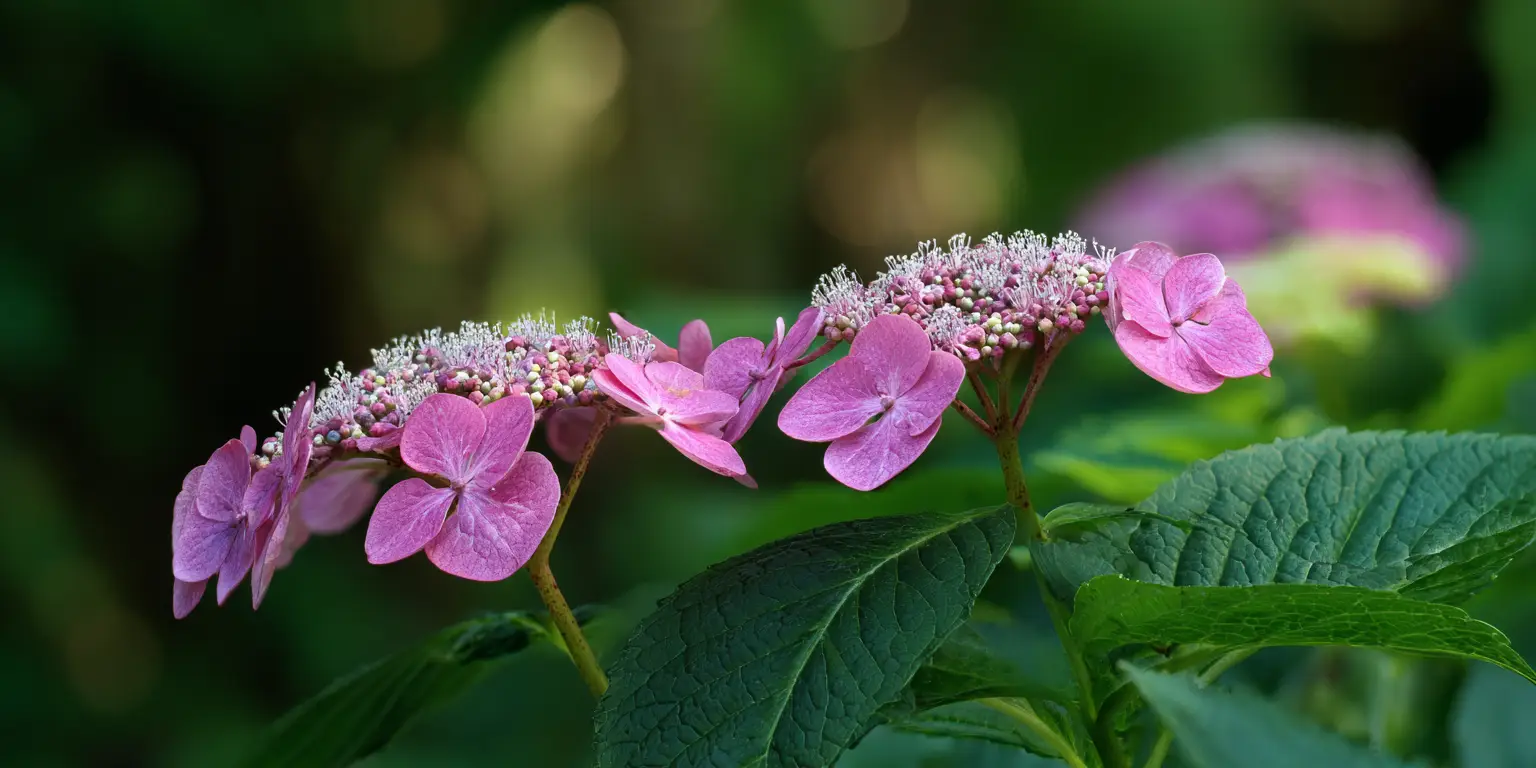
👃 Fragrance
Unlike many flowering shrubs, Hydrangea macrophylla’s allure lies almost entirely in its visual appeal rather than scent. The large clusters of hydrangea blooms are generally not fragrant. Gardener’s planting bigleaf hydrangeas should not expect a perfumed presence in the way that lilacs or roses might perfume the air. When you approach a blooming hydrangea, you’ll notice its impressive coloration and form, but there is little to no noticeable floral scent. This lack of fragrance is normal for most hydrangea species. A few rare cultivars have been noted to carry a mild fragrance – for instance, the cultivar ‘Ayesha’ reportedly has a light, sweet scent if smelled up close – but these are exceptions rather than the rule. The majority of Hydrangea macrophylla varieties have neutral-smelling flowers. On the plus side, the absence of strong fragrance means hydrangeas are unlikely to attract as many wasps or bees based on scent alone (though their blooms do still offer nectar to some pollinators). It also makes them suitable for those who enjoy bringing cut hydrangea blooms indoors, the blossoms can grace a vase and provide color without overwhelming a room with fragrance. In essence, while a hydrangea won’t tickle your nose, it will certainly please your eyes with its vibrant and luxurious blossoms.
⚠️ Toxicity and pet safety
Gardeners should be aware that Hydrangea macrophylla is mildly toxic if ingested by humans or pets. All parts of the plant – leaves, flowers, and stems – contain small amounts of cyanogenic glycosides. When ingested in sufficient quantity, these compounds can release cyanide, which is harmful. In practice, cases of severe poisoning are rare, because one would have to eat a considerable amount of plant material, however, even a small nibble can cause gastrointestinal upset. Symptoms in cats, dogs, or other animals that chew on hydrangea may include vomiting, diarrhea, lethargy, and depression. Typically, the reaction is a digestive irritation rather than life-threatening cyanide poisoning, but it can still be quite unpleasant and require veterinary attention. For pet safety, it’s best to plant hydrangeas where curious cats or dogs can’t easily munch on them, or supervise pets in gardens with hydrangea present. Children should also be taught not to chew on or eat any parts of ornamental plants, hydrangeas included. Wearing gloves when pruning or handling the plant is optional – hydrangea sap isn’t known to cause serious skin reactions for most people (unlike, say, poison ivy), though some individuals with sensitive skin might experience slight dermatitis from contact with the foliage. In floral arrangements, hydrangea stems are safe to handle, but again should not be ingested. If one suspects a pet or person has eaten hydrangea parts, monitor for symptoms and consult a veterinarian or poison control center as a precaution. In summary, hydrangeas are not pet-safe for consumption, so use caution in placement and keep an eye on pets and young children around these shrubs.
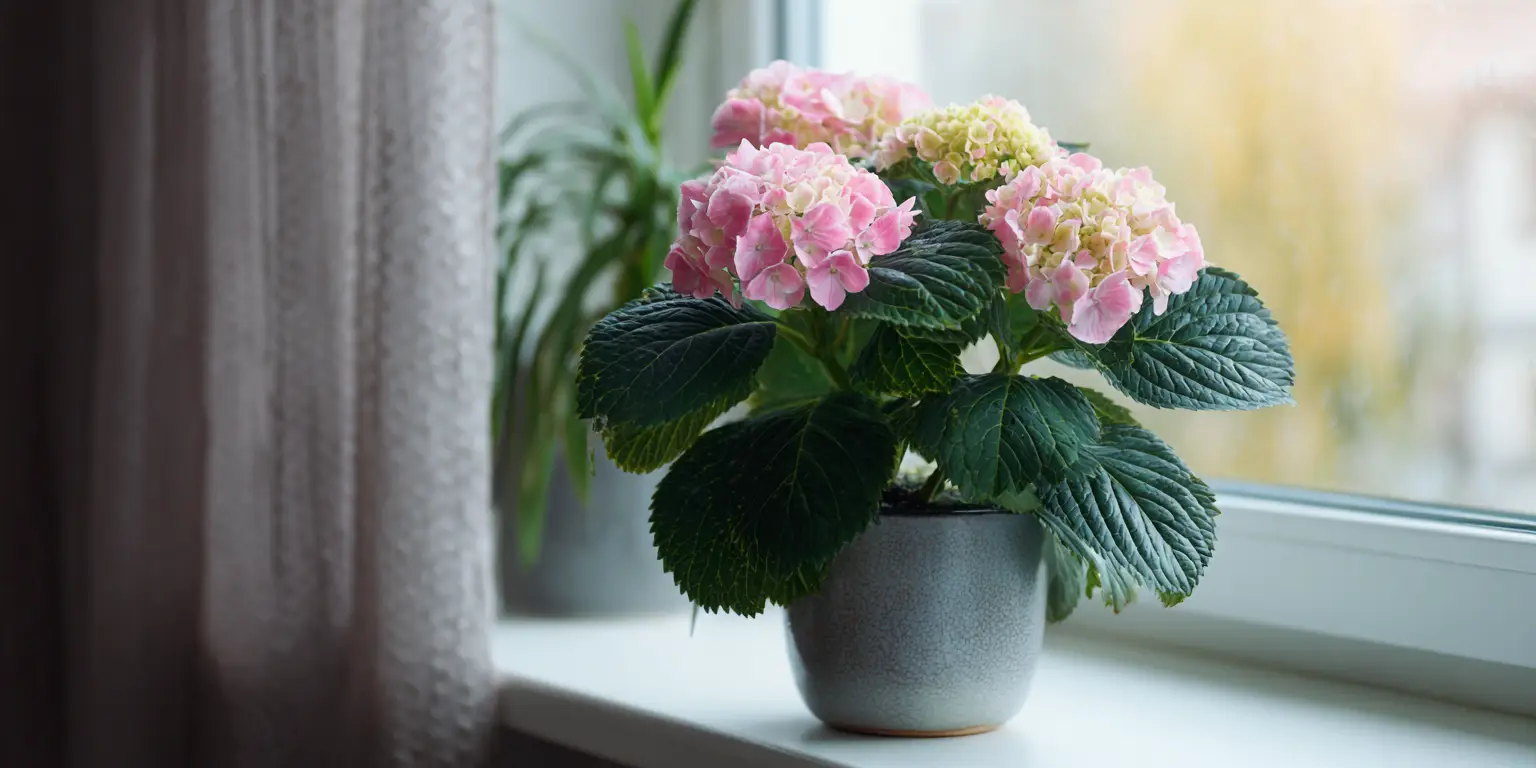
🌿 Vase life
Hydrangea macrophylla blossoms make stunning cut flowers, but they have a bit of a reputation for wilting if not handled correctly. With proper care, cut hydrangea flowers can have a vase life of about 5 to 9 days, and sometimes up to two weeks. The key to prolonging their freshness is hydration. When cutting hydrangea stems for arrangements, it’s best to do so in early morning when the plant is fully turgid (well-watered) and temperatures are cool. Immediately place the cut stems into water to prevent them from sealing up. Remove most of the leaves from the stem, large hydrangea leaves transpire a lot of moisture and can hasten wilting. One popular florist trick to extend vase life is to dip the cut end of hydrangea stems in alum powder (a spice commonly found in the grocery store) or briefly in boiling water for 30 seconds. These methods help improve water uptake by preventing the sap from blocking the stem’s vessels. Once arranged in a vase, ensure the water is deep enough to cover the stems well. Change the water every couple of days and recut the stems at an angle to keep them drinking. If you notice a bloom starting to wilt prematurely, you can try submerging the entire flower head in cool water for 15-20 minutes – hydrangeas can absorb water through their petals, which sometimes revives a limp bloom. In terms of display, keep hydrangea arrangements out of direct sunlight and away from heat sources or drafts. An added benefit: hydrangea blooms also dry beautifully. You can hang clusters upside-down in a cool, dry place or simply let them dry in the vase with a small amount of water. Dried hydrangea flowers retain an attractive form and subtle color, allowing you to enjoy them for months as ever-lasting bouquets or craft material. With a little extra care in conditioning the stems, Hydrangea macrophylla can be a delightful and relatively long-lasting cut flower for your home.
🐛 Pests and diseases
Hydrangea macrophylla is generally a robust shrub, but it can occasionally be bothered by certain pests and diseases, especially if the plant is stressed or conditions are not ideal. Among insect pests, aphids are perhaps the most common – these tiny soft-bodied insects might cluster on new growth and flower buds, sucking sap and excreting sticky honeydew. They can usually be managed by spraying them off with water or using insecticidal soap if infestations become heavy. Spider mites may appear in hot, dry weather, causing a speckled look to the leaves, keeping the plant well-watered and occasionally misting the foliage can deter mites, as they thrive in dry conditions. Scale insects (such as hydrangea scale) can attach to stems and undersides of leaves, these appear as small bumps and can cause leaf yellowing. Treating scale can require horticultural oil or systemic insecticides in severe cases. Larger critters can be an issue too – deer are known to feed on hydrangea leaves and flower buds, sometimes severely disfiguring the shrub, so protective measures (like netting or repellents) may be needed if deer are prevalent.
Disease-wise, fungal leaf spots (like Cercospora leaf spot) commonly occur on bigleaf hydrangeas, especially late in the season or in damp conditions. These show up as small brown or purplish spots on leaves. While they make the foliage look less attractive, they are mostly cosmetic and usually don’t seriously harm the plant, cleaning up fallen infected leaves in autumn can help reduce spore carryover. Powdery mildew is another ailment that can affect hydrangea leaves, manifesting as a white, powdery film on the surface. It tends to happen in humid, shaded locations with poor air circulation. Ensuring adequate spacing, pruning for airflow, and applying fungicide when needed can manage powdery mildew. Botrytis blight (gray mold) might sometimes attack the flowers in prolonged wet weather, causing blooms to turn brown and mushy – removing spent blossoms and providing air circulation helps prevent this. In terms of more serious problems, bacterial wilt and hydrangea viruses exist but are not widespread, if your plant wilts and blackens inexplicably or has unusual mosaic patterns on leaves, it could be a systemic issue, and affected plants should be removed to avoid spreading pathogens. Root rot can occur if the soil is waterlogged, emphasizing the importance of good drainage. Overall, a healthy Hydrangea macrophylla grown in proper conditions will have minimal issues. The best defense is preventive care: plant in the right spot, avoid overhead watering (to keep leaves dry), and maintain vigor through proper feeding and pruning. Regularly inspect your hydrangea so that if pests or disease do appear, you can intervene early with appropriate remedies, ensuring your shrub stays lush and beautiful.
FAQs
How do I change Hydrangea macrophylla flower color?
You can change the bloom color of Hydrangea macrophylla by altering the pH of the soil over time. For blue flowers, the soil needs to be acidic (pH around 5.0-5.5) so that aluminum in the soil is available to the plant. To encourage blue hues, gardeners often add aluminum sulfate or soil acidifier (sulfur) according to package directions, usually applying it in the fall and again in early spring. For pink flowers, the soil should be more alkaline or neutral (pH around 6.0-6.5), adding garden lime can help raise the pH and reduce aluminum uptake, resulting in pinker blooms. Always make these changes gradually and test your soil pH first – extreme swings can harm the plant. Also note that pure white hydrangea varieties won’t change color with soil pH, they’ll remain white or maybe green-tinted as they age. It may take a season or two for the color change to fully manifest. Consistency is key: monitor pH and reapply amendments as needed, because regular rainfall and irrigation can buffer the soil back towards neutral. With patience, you can have some fun changing hydrangea color from pink to blue or vice versa, effectively giving you a new look on the same plant.
When should I prune Hydrangea macrophylla?
Timing is crucial because Hydrangea macrophylla blooms on old wood (last year’s growth). The best time to prune is immediately after flowering – typically by mid to late summer once the main flush of blooms has faded. Pruning right after bloom allows the plant time to set new buds in late summer and fall for the next year. If you prune too late in the year (for example, in fall or in early spring), you risk cutting off the developing flower buds and your hydrangea may not bloom the next season. In general, these hydrangeas do not require heavy pruning annually. Limit pruning to removing spent flower heads (deadheading), trimming back a bit of stem to a pair of healthy buds, and cutting out any truly dead, damaged, or weak stems at the base. Every few years, you can also remove one or two of the oldest woody stems entirely to encourage fresh vigorous growth from the base – this is a form of renewal pruning that keeps the shrub healthy and within bounds. Always use clean, sharp pruners to make cuts. If you have a reblooming variety that flowers on new wood as well, light pruning after the first bloom flush can sometimes encourage a second bloom, but avoid cutting back too much. A good rule of thumb for pruning hydrangeas of the bigleaf type is: “if in doubt, don’t prune” – aside from removing dead parts – to ensure you don’t accidentally sacrifice next year’s blossoms.
Why isn’t my Hydrangea macrophylla flowering?
If your hydrangea isn’t blooming, there are a few common reasons to investigate. Incorrect pruning is the top cause – as mentioned, if a Hydrangea macrophylla is trimmed at the wrong time (e.g., cut back hard in fall or spring), the flower buds that were set on old wood may have been removed. Another major factor is winter or early spring cold damage. In colder zones, even if the shrub itself survives, the dormant flower buds can be killed by freezing temperatures or a late frost, resulting in lots of healthy green leaves but no blooms in summer. For those in chillier climates, this is a frequent frustration with bigleaf hydrangeas. Protecting the plant over winter or choosing a reblooming (new wood blooming) cultivar can help. Light conditions play a role too – too much deep shade can reduce flowering, since the plant may not have enough energy to produce blooms. Ensure it’s getting at least some morning or gentle sun. Additionally, over-fertilization, particularly with high-nitrogen fertilizer, can cause hydrangeas to focus on leaf growth at the expense of flowers. If you’ve been feeding heavily (especially lawn fertilizer nearby), cut back on nitrogen, use a more balanced or phosphorus-rich fertilizer to promote blooming. Also consider the age of the plant – new hydrangeas or those moved/transplanted may take a couple of years to establish and flower well. Lastly, check for any signs of stress or disease that might weaken the plant. Addressing these issues – pruning habits, cold protection, light, nutrition – will usually get your hydrangea back on track to bloom. Once conditions are right, Hydrangea macrophylla is a prolific bloomer, so troubleshooting the cause of no flowers is well worth the effort.
Can Hydrangea macrophylla grow in full sun?
Hydrangea macrophylla can grow in full sun in certain situations, but generally it prefers partial shade. In cooler climates (for example, coastal regions or far north areas with mild summers), hydrangeas can handle a lot more sun as long as they have ample water. In those conditions, full sun exposure might even result in very robust flowering. However, in hot climates or during the peak of summer afternoons, full sun can be quite harsh on bigleaf hydrangeas. The broad leaves will lose moisture fast and can develop scorched brown edges or patches if exposed to intense sunlight combined with high temperatures. You will also notice the plant wilting nearly every afternoon in full sun, which stresses it (even if the soil is moist). If your garden is in zone 8 or 9 with strong sun, it’s advisable to provide at least some afternoon shade. A location with morning sun and afternoon shade (such as the east side of your house or under the high canopy of a tree) tends to be ideal and encourages lots of blooms without as much stress. If full sun exposure is unavoidable, be prepared to water more frequently and use a thick mulch to keep roots cool. Also consider planting the hydrangea in a spot where something will cast a shadow on it during the hottest part of the day. In summary, yes, hydrangeas can survive in full sun especially in mild regions, but for the happiest plant with lush foliage and enduring blooms, partial shade is usually the better choice.
Does Hydrangea macrophylla need winter protection?
That depends on your local climate. In USDA zones 6 and warmer, Hydrangea macrophylla typically does not require much winter protection for the plant to survive, apart from perhaps a layer of mulch over the root area to moderate soil temperatures. However, even in these zones, a sudden late frost in spring can damage new growth or buds, so some gardeners throw a light blanket or burlap over their hydrangea if a freeze is forecast when buds are swelling. In colder regions (zone 5 and colder), some level of winter protection is recommended if you want to ensure blooming. The wood and buds of bigleaf hydrangea can be damaged by severe cold. Gardeners in these areas often will cage the plant in late fall (for example, encircle it with chicken wire) and fill the cage with dry leaves or straw as insulation. Another method is to wrap the shrub loosely in burlap. These techniques help the buds survive subzero temperatures. Even just piling a thick mound of mulch or leaves around the base of the plant (covering the lower stems) can protect some buds that are lower to the ground. Hydrangeas in pots definitely need protection as their roots are more exposed – either move the pot into an unheated garage or insulate the container. If your hydrangea consistently dies back to the ground each winter (common in zone 4), you might consider switching to a reblooming variety that can flower on new wood, or treat it as a foliage plant, understanding blooms will be limited. Also remember not to prune in fall – leaving the stems intact (even if they look a bit bare) can give extra protection because often the old canes shield the buds further down. Come spring, once the danger of frost passes, you can remove any winter coverings. With some thoughtful protection in harsh climates, you increase your chances of enjoying a full floral display come summer.
Interesting tips
- Hydrangeas as pH indicators: Hydrangea macrophylla’s color-changing ability can be a fun garden experiment. If you’re curious about your soil’s pH, watch your hydrangea’s blooms – blue flowers generally signal acidic soil, while pink means a more alkaline soil. It’s like having a living soil test in your yard (though for precise readings, you should still use a soil test kit!).
- Using hydrangeas in bouquets: To avoid premature wilting of hydrangea cut flowers, try an old florist’s trick – immediately after cutting, dunk the stem end in alum powder. This helps keep the water uptake channels open. Alternatively, you can sear the end of the cut stem in boiling water for 30 seconds. These methods, along with removing excess leaves, will let you enjoy dried flowers or fresh arrangements for longer.
- Container cultivation: If your garden soil isn’t ideal (too alkaline or heavy clay), consider growing Hydrangea macrophylla in a large pot. Containers allow you to control the soil type and pH more easily. You can use an ericaceous (acidic) potting mix for blue blooms, for instance. Just be vigilant with watering, as potted hydrangeas can dry out faster. In cold areas, move pots to a sheltered spot in winter to protect roots from freezing.
- Winter interest: Don’t be too quick to remove spent blooms at the end of the season. Dried hydrangea flowers can look lovely in the winter landscape, often turning parchment-gold and catching frost beautifully. They also provide a bit of natural protection to the buds below. Consider leaving the dried flower heads on the plant until late winter – they add texture to the garden and can be snipped off in early spring before new growth begins.
- Companion planting: Hydrangea macrophylla pairs well with other shade-tolerant plants. Try planting it alongside azaleas, hostas, or ferns, which enjoy similar soil and light conditions. For season-long color, you can have spring bulbs or morning glories nearby (morning glories will climb and add vertical interest with their blue blooms, then hydrangeas take center stage in summer). Such combinations create a dynamic display and ensure your garden has successive waves of color.